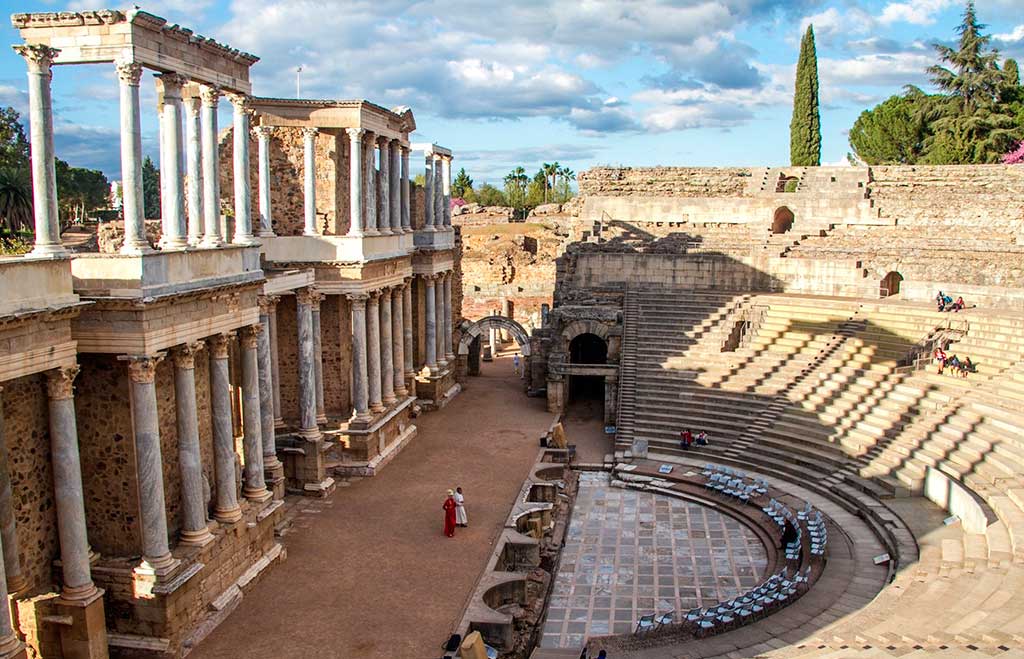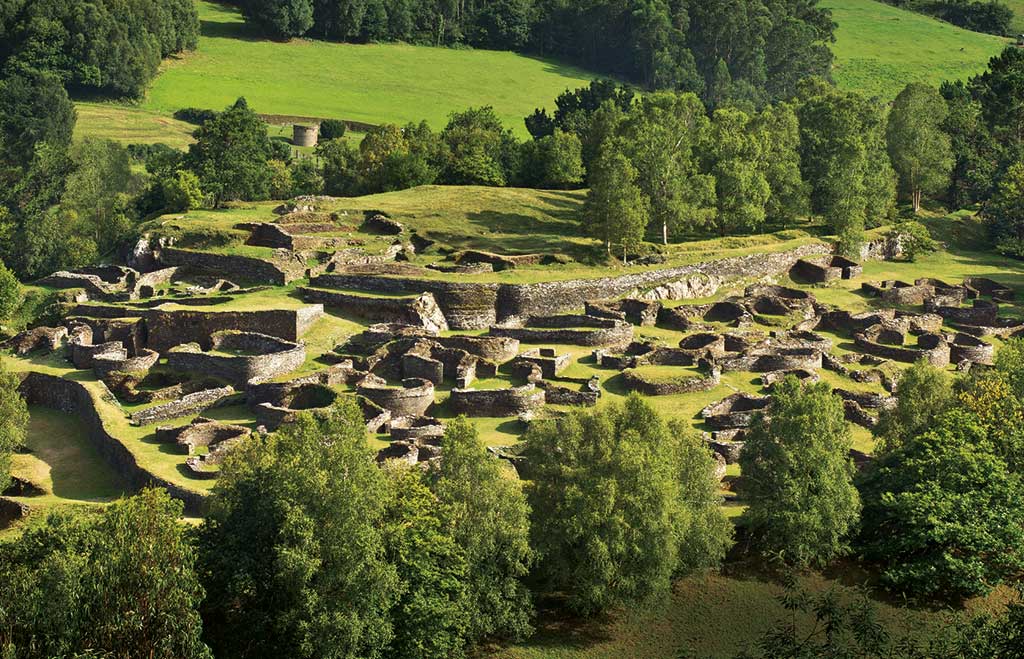While many travelers’ first introduction to Spain is via her beautiful beaches, Mediterranean cuisine and cosmopolitan cities, the country’s cultural and historical allure is where her beauty really lies. It’s not altogether surprising, then, to learn that Spain is sixth on the list of the largest archaeological destinations in the world.
Spain has eight sites and sets of archaeological sites that have been declared World Heritage Sites, a fact which is indicative of the area’s rich architectural wealth and the variety of different peoples and societies that developed in the Iberian Peninsula.
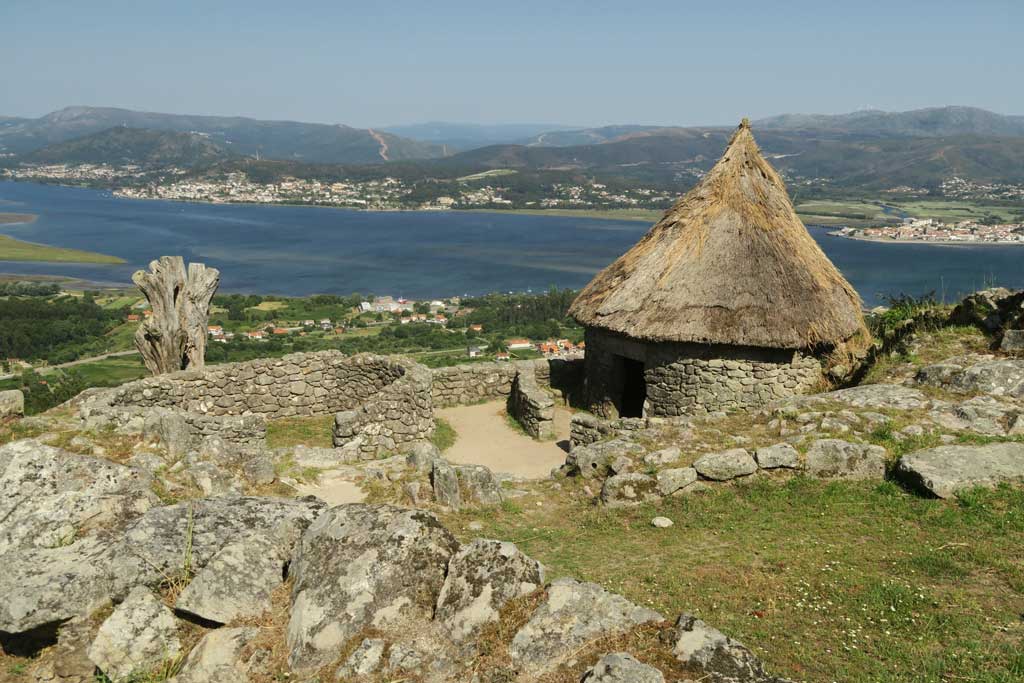
Saint Tecla (Pontevedra)
The evolution of multiple cultures has left impressive remains that make Spanish archeology of the most impressive in the world. If history interests you and you are passionate about archeological discoveries, Spain is one country that you won’t be able to stop visiting.
- In Andalusia: Visit important cities such as Medina Azahara (Córdoba), one of the best examples of Arab settlement in Spain, and in Itálica (Seville), visit a city that witnessed the birth of the two most important Roman emperors in history: Trajan and Hadrian.
- In Catalonia Tarraco, the ancient capital of the Roman province of Tarraconensis: Marvel at an ancient wall, a forum, a circus, an amphitheater, an aqueduct, Scipios Tower (a funerary tower built by the Romans), numerous Roman villas, and Ampurias, a settlement in front of the sea.
- In Cantabria, in the north of Spain: Admire the prehistoric caves of Altamira in awe. This setting is comprised of 18 caves exhibiting paleolithic rock art, with big parallels to the famous Lascaux’s paintings in France.
- In León: Wander the open-air gold mines of Las Médulas – it’s an experience that you will never forget.
Visiting these archaeological sites with us today is like taking a trip back in time to witness the very beginnings of humanity. With 3D technology and spectacular, expert recreations, understanding the passage of time that gave birth to so many different civilizations in the Peninsula is an incredibly vivid and humbling experience.
A Guarda is one of the most significant locations in Galicia, largely due to the Saint Tecla mountain. This is a must-visit spot, popular for its rich archaeological, religious and natural heritage.
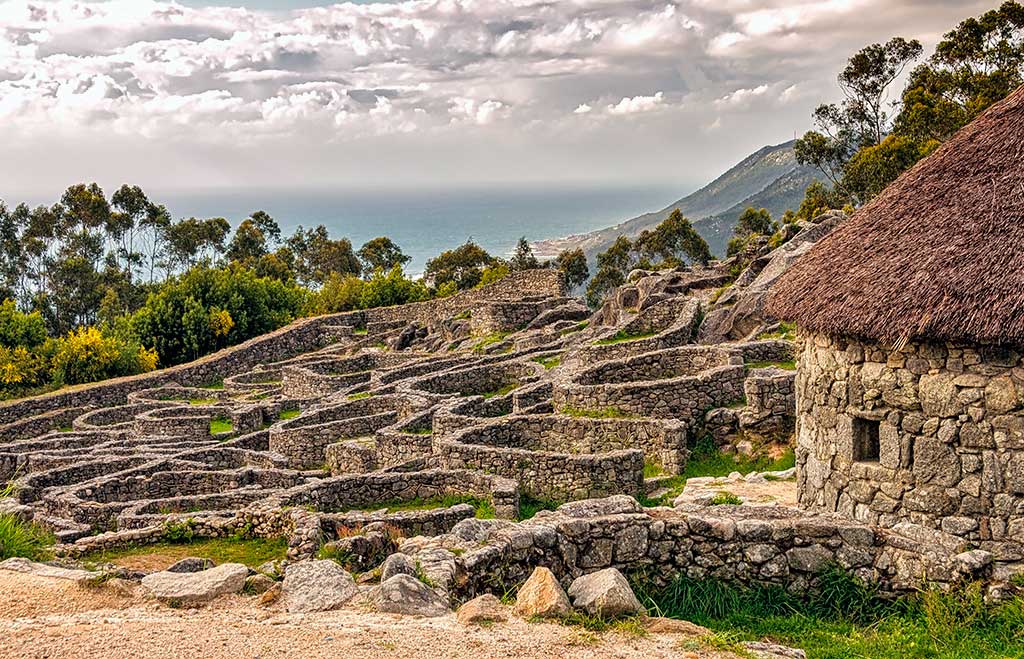
The “citania” (village) of Santa Trega is known to contain the ruins of an ancient Galician fort and vast archaeological site 341 meters above sea level, strategically located to overlook the mouth of the river Miño. This area is considered to be one of the most important examples of the Castrexo-Roman culture of north-western Spain. The most significant archaeological site occupies a 20-hectare area, of which only a small part has been excavated. The documented origins of the site are from the 4th century BC, with evidence pointing to a population of between 3.000 – 5.000 inhabitants settling there.
The Society Pro Monte, founded in 1912, thanks to the interest of the “indianos” (returned emigrants) from A Guarda, undertook the first archaeological excavations. The last excavation ended at the beginning of 2016, led by Rafael Rodriguez and funded by the Deputation of Pontevedra and the Spanish Ministry of Development. This last excavation largely focused on the period between 1928-1933, a period that was also studied by the University of Valladolid’s archaeologist, Cayetano Mergelina y Luna.
Source:
https://www.turismoaguarda.es/en/monte-santa-trega/#!
The Atapuerca archeological site is located near the city of Burgos, in the autonomous community of Castile and León, in the North of the Iberian Peninsula.
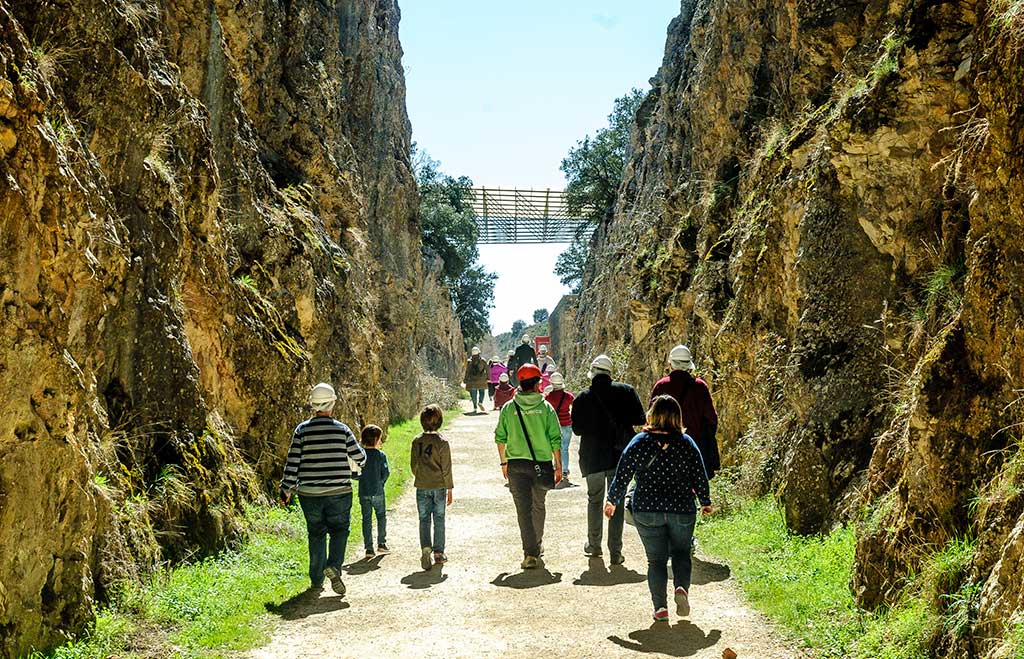
The sites contains a rich and vast fossil record, starting with the earliest human beings in Europe, from nearly one million years ago, and extending all the way into the Common Era. It constitutes an exceptional scientific time span of data that provides priceless information about the appearance and way of life of these remote human ancestors. In fact, the earliest and most abundant evidence of humankind in Europe is found in the Sierra de Atapuerca.
Not far from the site is the Human Evolution Museum in Burgos City – a great stop for archeology fans. It showcases unique exhibits around the origin and evolution of the human race and it serves the important function of being the base at which materials and findings from the Atapuerca archeological research project are kept and studied.
The museum, designed by the architect Juan Navarro Baldeweg, includes more than 25 large-format projections, 360º circular projections and more than 50 video sources, controlled by an automation system and synchronized with special effects.
Sources:
http://www.patrimoniocastillayleon.com/en/atapuerca
https://whc.unesco.org/en/list/989/
https://en.wikipedia.org/wiki/Museum_of_Human_Evolution
The Altamira Caves, declared a UNESCO World Heritage Site, are located in Santillana del Mar, a small town in Cantabria.
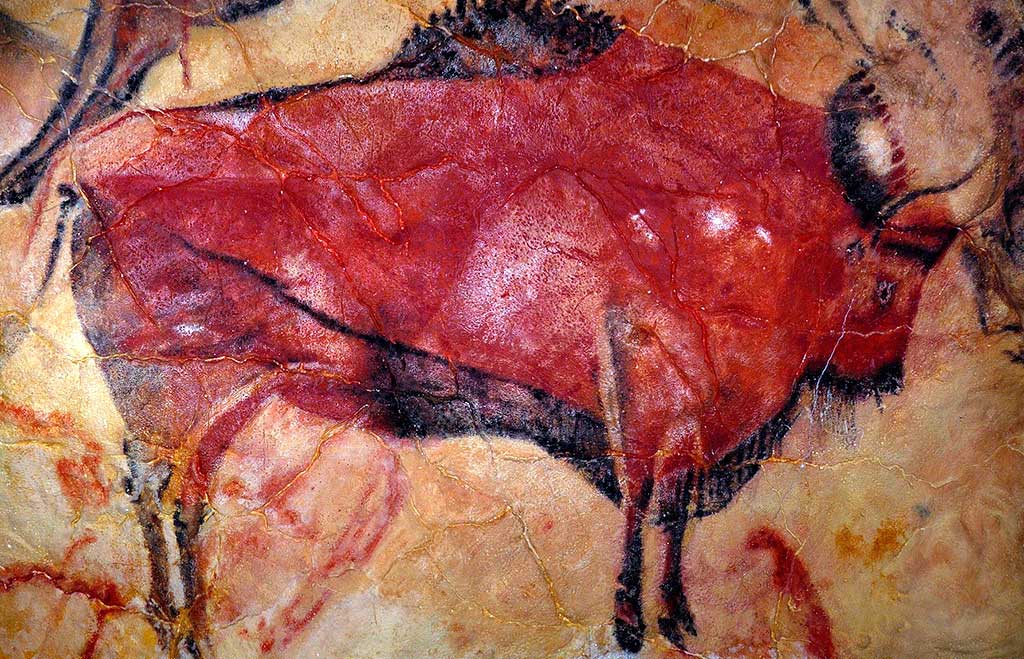
They are one of Spain’s most important tourist attractions and receive over 250.000 visitors every year.
The caves were inhabited some 22.000 years ago. They were later abandoned and the entrance to them was likely blocked by its rock wall collapsing around 13.000 years ago, which accounts for the high humidity and stable temperatures that helped paintings preservation.
Discovered by chance in 1879, the Altamira Caves are today amongst the best prehistoric paintings in the world, often compared with Lascaux in France.
The original cave is 270 meters long. To preserve this cave, a replica was built. Besides 5 lucky visitors who are randomly selected to visit the original cave every day, all other visitors will only ever see the replica cave.
The caves are divided in several rooms and feature paintings of animals (deers, horses, bison, and goats), hands and other geometrical shapes. Up to 25 bison can be found at the Great Room, the most famous room in the caves.
Source:
https://makespain.com/listing/caves-of-altamira-in-cantabria
Visiting Segóbriga Archaeological Park, in Saelices, in the province of Cuenca, Castile-La Mancha, Spain, is like stepping back in time.
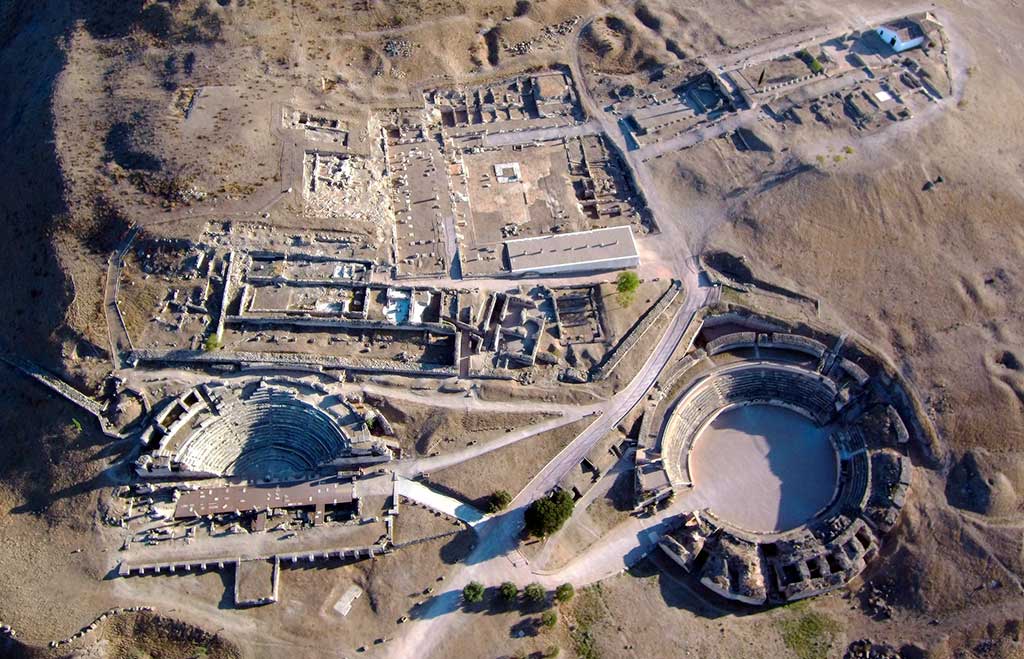
This Celtiberian burial site, containing human remains and artifacts dating back to the Bronze Age, was discovered inside a cave in 1888. Gradually, architectural relics from the Roman era were unearthed in the surrounding area. This wasn’t just a burial site; this was one of the most important cities in the ancient Roman world.
Originally a Celtic settlement, Segóbriga was conquered by the Romans in the second century BC. Public baths, city walls, an acropolis, and a massive amphitheater seating 5 500 spectators were erected under Roman rule. Many of these structures have survived and remain in good condition.
The city began to decline in the late imperial years, and most inhabitants moved to present-day Saelices. By the time of the Reconquista, Segóbriga had been largely abandoned. The site was declared a National Monument in 1931 and to this day the park remains an incredibly important Celtic-Roman archaeological site and a well-preserved portal to the ancient past.
Chat to our Viabo team should you be interested in seeing a dramatization, attending a workshop, going on a guided night tour, or planning a day visit to the park, accompanied by an archeologist.
Source:
https://www.atlasobscura.com/places/segobriga-archaeological-park
The Tito Bustillo Cave, situated in the town of Ribadesella, is one of the most important Paleolithic cave art sites in Europe.
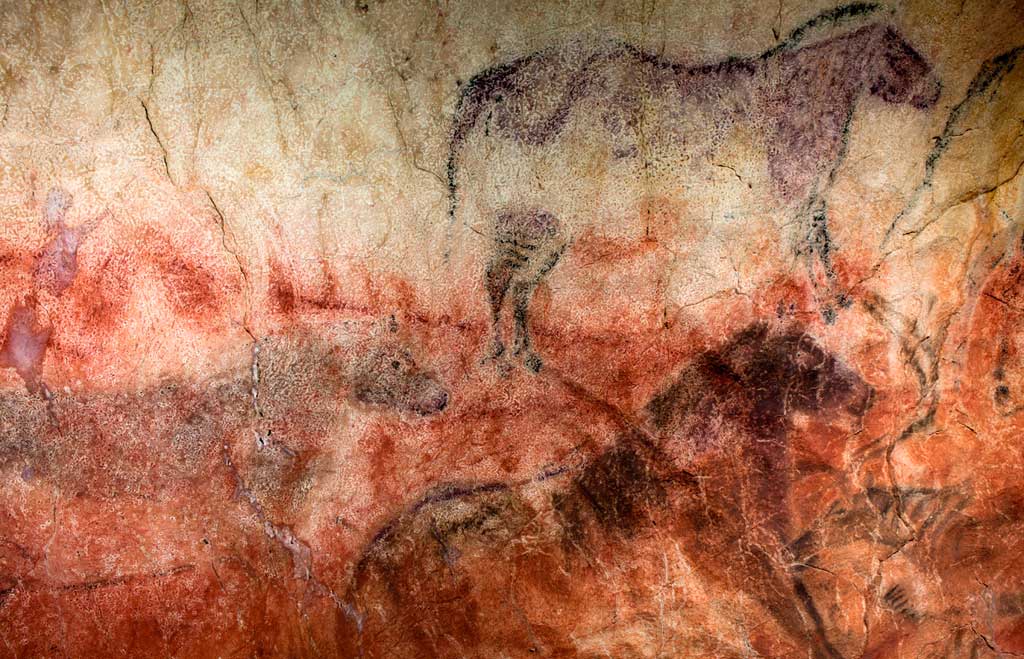
So much so, in fact, that in 2008 it was declared a World Heritage Site, together with 4 other Asturian caves and 9 more in Cantabria and the Basque Country.
The Main Panel is the only room open to the public and the most important one because of the large number of representations and the wide variety of artistic techniques and styles.
A traditional inventory registered almost a hundred representations, with fauna outnumbering signs: 30 deer, 13 horses, 9 reindeers, 5 goats, 4 bison, 1 auroch, 2 unidentified animals, 17 signs and 10 lines.
Experts have noted that the representations correspond to two distinct phases (and two different time frames):
- Early or Pre-Magdalenian (typified by red signs and scant animal figures)
- Later or Magdalenian (executed on a large stain of red pigment and engraved with multiple striated lines, a formal and technical stereotype widely used in northern Spanish cave art, as well as red, black and violet zoomorphic representations – predominantly horses and reindeers)
When visiting the Tito Bustillo Cave, consider adding a stop to the adjoining Ardines Cave (an immense geological dome) and the nearby Tito Bustillo Center of Rock and Cave Art. The center offers an overview of rock art in the Asturian region and an exhibition of various items of archaeological interest, particularly from the Tito Bustillo Cave itself, with unique mock-ups.
Sources:
https://www.turismoasturias.es/en/descubre/cultura/arte-rupestre/rupestre-cueva-de-tito-bustillo
http://www.centrotitobustillo.com/en/3/visitas/36/prepara-tu-visita/46/a-la-cueva-de-tito-bustillo.html
The archeological site of Contrebia Leucade is located in the province of La Rioja, more specifically 2.5 km from the municipality of Aguilar del Río Alhama.
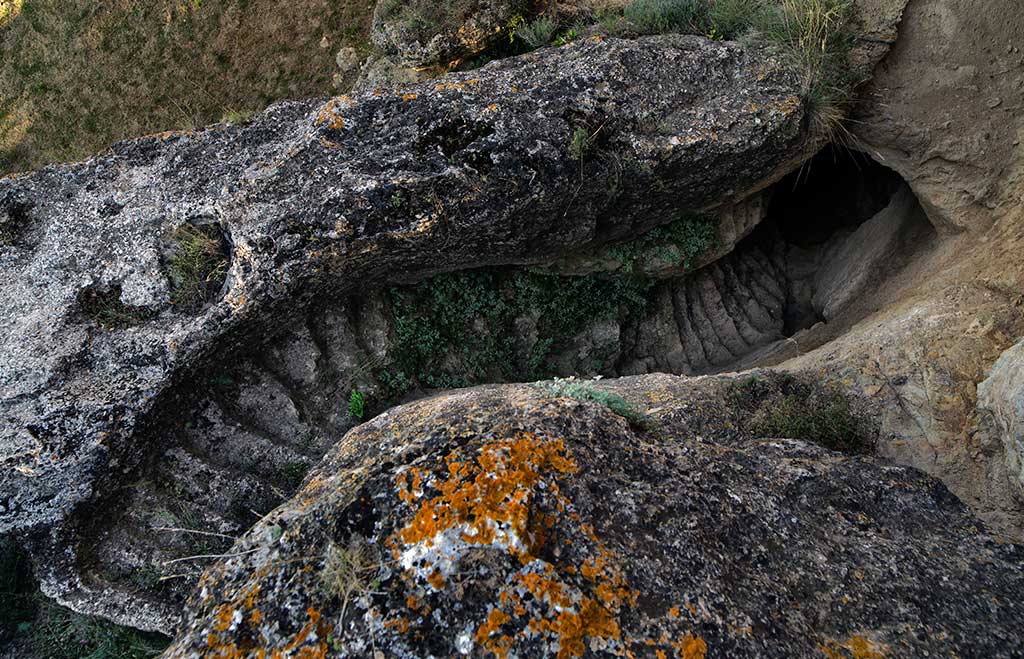
It is one of the most important Celtiberian archaeological sites of Spain, both for its size and for its unique features.
The site was successively a Celtiberian, Roman, Visigoth and Medieval settlement, whose origins date back to the Bronze Age, a period in which the site housed a collective burial called the “Cave of the Lakes”. During the Celtiberian period it was inhabited by the tribe of the Arévacos. Later it became involved in the Sertorian wars among different Roman factions in the Iberian Peninsula.
The archaeological site is fascinating for the depth and detail with which it reveals the Celtiberians’ technical development and organizational capacity, seen in the construction of the site’s impressive defensive system, in the well carved into the rock to ensure a water supply, and in the studied and careful arrangement of the houses.
Visitors wanting to see the site should go to the Contrebia Leucade Interpretation Center, located in Aguilar del Río Alhama. Our Viabo team can arrange a guided tour of the site and also include a visit to the nearby Chapel of the Virgen del Prado, a shrine next to which there is a small paleontological deposit of dinosaur footprints.
Sources:
http://www.contrebialeucade.com/categoria/1/2
http://www.vinoturismorioja.com/en/monuments-museums/item/987-contrebia-leukade-archaeological-site
The town of Las Médulas is located in the region of El Bierzo, Leon.
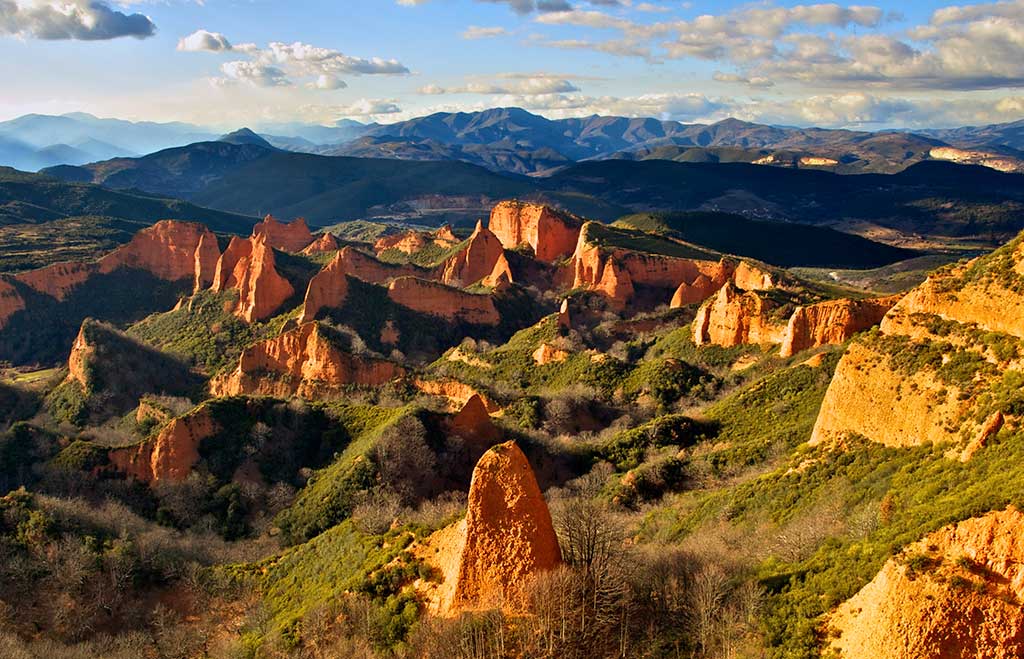
This small mountain town marks the natural beginning of the ascent towards Las Médulas, a unique cultural landscape that was declared a UNESCO World Heritage Site.
The serrated silhouette of this landscape, marked by red clay mountains, owes its appearance to the Romans, who altered the natural environment in the area when they established an open cast gold mine in the 1st century AD.
It is one of the few open-cast gold mines exploited by the Romans that is still preserved today. In order to extract the gold, the Romans came up with an ingenious system called “ruina montium” – a method using water force to crumble the soil and expose the gold.
Their system is a work of great engineering and sublime Roman genius, but it changed the natural landscape forever. After two centuries of “ruina montium”, the result was the formation of Las Médulas – red clay erosion gullies, towers, and underground galleries, all surrounded by chestnut trees. Peaks higher than 100 meters lead to the center of the gold mine, the Cueva Encantada (Enchanted Cave) and Cuevona (the Huge Cave).
For the best views of Las Médulas, go to Orellán, which is 8 kilometers away. You might also want to stop in the town of Las Médulas and browse the exhibitions on display at the Archeological Learning Center.
Sources:
https://www.spain.info/en/destination/las-medulas
https://destinocastillayleon.es/index/las-medulas-de-leon-un-paisaje-patrimonio-de-la-humanidad
La Olmeda Roman Villa was discovered while doing some agricultural work on a piece of land near Pedrosa de la Vega (Palencia).
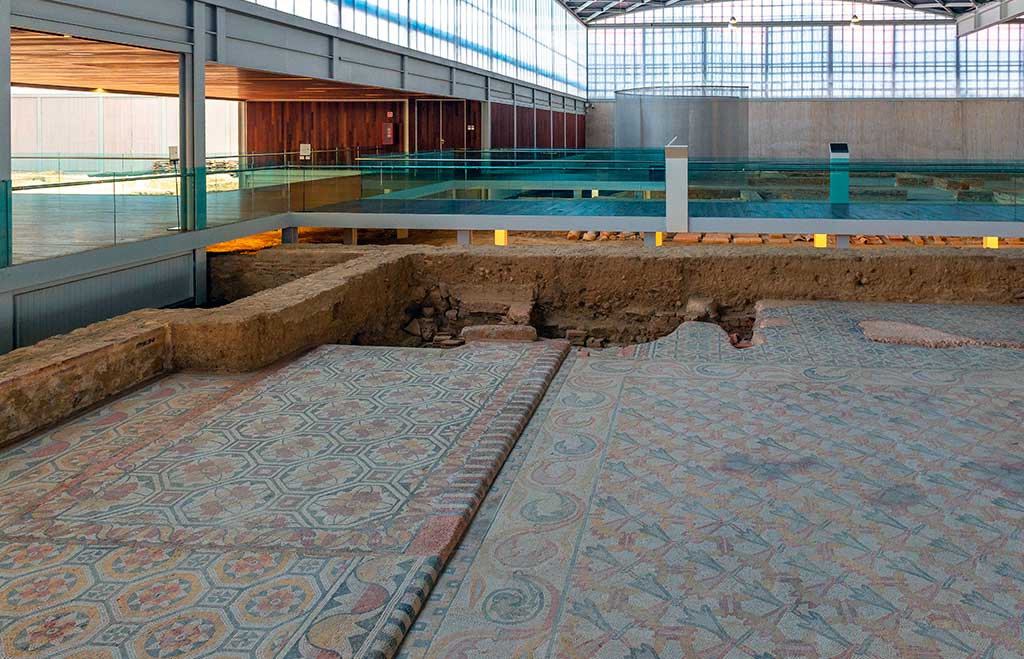
In the beginning of the summer of 1968, a tractor rode over the remains of an ancient wall and that was the starting point of the archaeological research. The mystery was cleared up with the discovery of a splendid Late Roman palatial villa – a whole complex of rooms, corridors, and porches dating back to 1600 years ago.
La Olmeda, declared an Asset of Cultural Interest in 1996, is one of the most important archaeological sites in the Spanish Roman world, featuring a big rural mansion (domus) of the Late Roman Empire (4th century AD). The main square building (pars urbana), the heart of a big agricultural estate, flanked by towers, is arranged around a central courtyard that opens towards different quarters, most of them paved with incredibly well-preserved mosaics.
This palatial villa covers an area of 4400 m² with 35 rooms divided between the main house and the baths complex (thermae). Out of the 35 rooms, 12 of them have a hypocaust (an underfloor heating system for the thermae), and 26 of them are decorated with 1450 m² of polychrome mosaics, preserved in situ.
The La Olmeda Roman Villa Museum is installed in the Church of San Pedro in Saldaña. A selection of the objects found during the excavations are exhibited there and given context in terms of how they would have been used in their original time and what the daily lives of the inhabitants of the villa might have been like.
Source:
https://www.villaromanalaolmeda.com/en/villa/olmeda/presentation
The archaeological site of La Tejada is located near the village of Quintanilla de la Cueza (Palencia), very close to the Camino de Santiago.
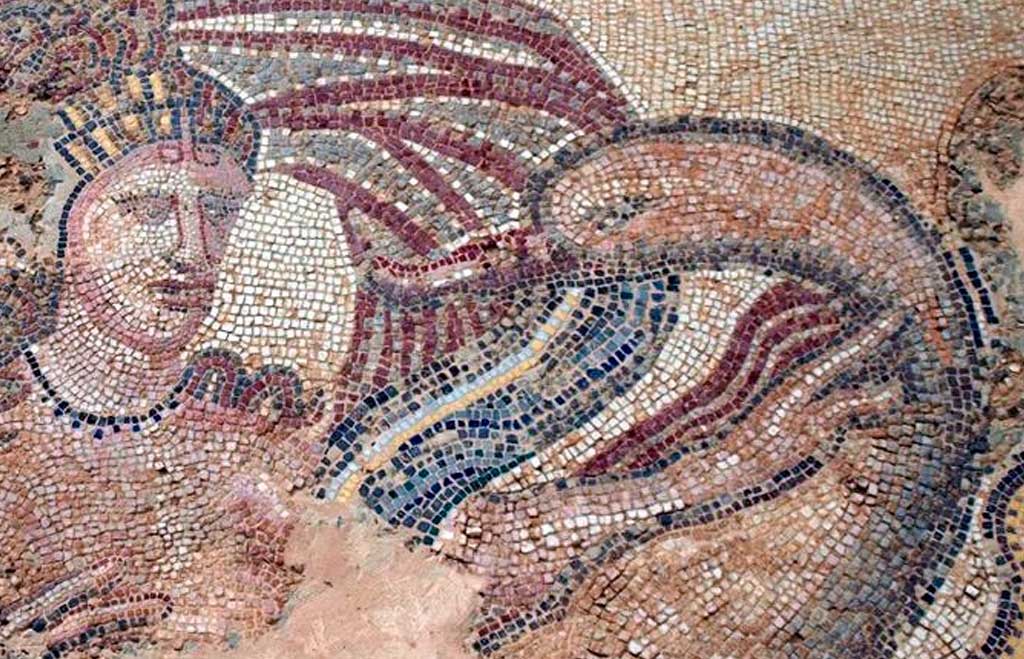
The name of the site comes from the name of the land on which it was discovered in 1970.
When visiting the site, travelers will see a wide range of rooms that reflect the luxury and comfort which existed in this part of the Empire from around the 1st to the 5th century AD. The splendid mosaics feature detailed and colorful geometric and figurative designs with mythological, marine or allegorical themes. In addition to this decorative richness, many rooms in its thermae exhibit a complex and sophisticated underfloor heating system, consisting of several types of hypocaustum with brick pillars, arches and underground galleries.
Although La Tejada is called a Roman ‘villa’, the characteristics of the structures that form it and the large extension of the site seem to indicate that it could possibly also have been the baths complex of a building that lodged travelers in transit via the nearby Roman road that connected Burdigala (Bordeaux) with Asturica Augusta (Astorga).
The excavated area is only a small part of the whole complex. Currently visitors can see the remains of three different building areas:
- Thirteen rooms arranged on a north-south axis, with limestone masonry walls alternating with rows of bricks.
- A large covered corridor oriented from east to west, in whose northern area there are six other rooms paved with mosaics.
- Another series of rooms, possibly used for storage.
Source:
https://www.villaromanalaolmeda.com/en/villa/tejada/presentation
Conímbriga, one of the richest archeological sites in Portugal, was originally a Celtic castro (fortified settlement) of the Conii tribe in the late Iron Age
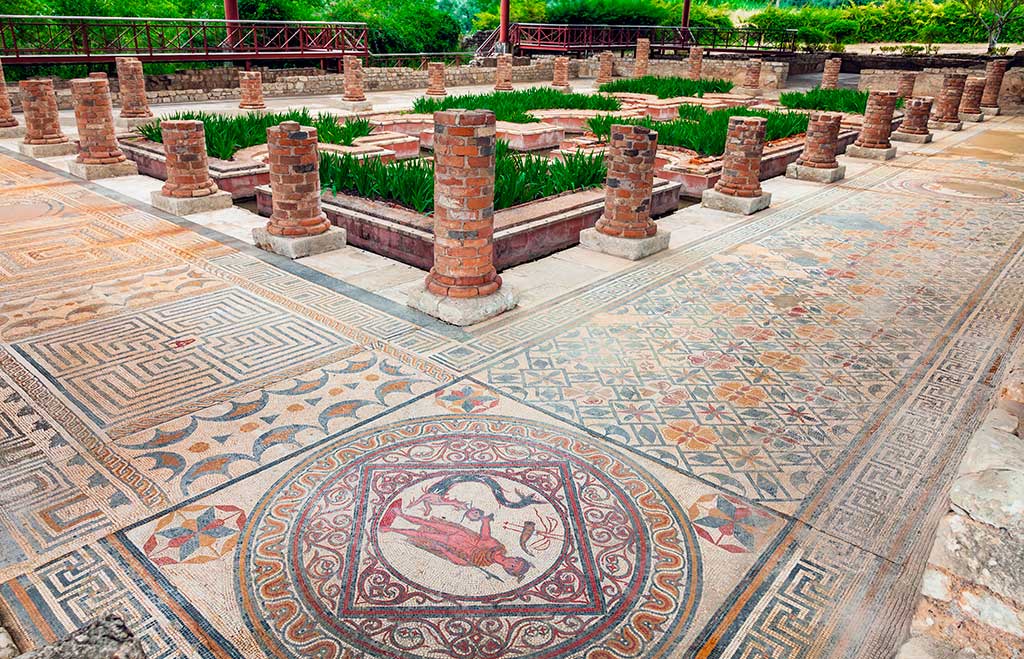
After 139 BC it was occupied by the Romans, and the inhabitants were totally Romanised. The town achieved its splendor under Emperor Augustus in the 2nd century AD, when the public baths and a forum were built (a recreation of which can be seen in the museum).
With the decline of the Roman Empire in the late 4th century, a monumental defensive wall was built. This did not prevent the town from being attacked by the Swabians in 468 AD, however, and led to the consequent decline of Conímbriga. The town was deserted, and the remaining residents moved further north to Condeixa-a-Velha.
Major excavations of the site during the 20th century revealed a rich and complex group of buildings underground, including baths, an aqueduct (running for more than 3 400 meters from the spring) and the remains of a Christian basilica that probably dates back to the 6th century.
Visitors are sure to be struck by the noble houses, which still retain their magnificent multicolored mosaic floors. The House of Cantaber, a typical 3rd-century residence and one of the largest in the whole of the western Roman world, is particularly remarkable, as is the Casa dos Repuxos (House of Fountains), with its 569 m² of mosaic floor. The floor is beautifully illustrated with scenes from mythology and daily life, and its central peristyle, with ornamental flower beds and water jets, make it unique.
Source:
https://www.visitportugal.com/en/NR/exeres/92C41078-FE3B-4D1E-95F6-689528EAA9DE
The Roman Theatre of Mérida is part of one of the largest and most extensive archaeological sites in Spain, declared a World Heritage by UNESCO in 1993.
The town was originally founded in 25BC and named Augusta Emerita by Octavius Augustus. It was a retirement place for Roman army soldiers from two veteran legions of the Cantabrian Wars. “Emeritus” stands for “retired” in Latin, hence the town’s name referral to soldiers retiring with honor.
The Theatre was commissioned by the consul Marcus Vipsanius Agrippa and constructed between 15 and 16BC. What was then a space with capacity for 6 000 spectators to enjoy staged games is today one of the most famous and visited landmarks in Spain, and, not surprisingly, chosen as one of the 12 Treasures of Spain.
The theatre underwent several renovations, notably at the end of the 1st century AD, when the stage was raised, and again in the 4th century AD, in the time of Constantine I, introducing new decorative-architectural elements and a walkway. Once Christianity became the official religion of the Empire, theatrical performances were considered immoral. Therefore, the theatre was abandoned and, later on, mostly collapsed. Only the ‘seven chairs’, i.e. the highest part of the grandstands, stood out on the ground. In local folklore the site was referred to as “The Seven Chairs”, where, according to tradition, several Moorish kings sat to decide the fate of the city.
“Castros” are ancient settlements in Asturias, Galicia and Cantabria dating back to before the Roman conquest.
Situated atop a hill, the ancient settlement of Coaña, dating back to the 4th century BC, is a particularly large and spectacular one, surrounded by a wall with a trench in front of it. Unlike other castros in the region, it’s extraordinarily well preserved.
Excavations of this pre-Roman archeological site have uncovered two main sectors: Firstly, the acropolis, which was a large oval area with a sturdy wall located on a hill. It served as a fortification. Secondly, the northern area, where more than 80 small circular constructions are conserved. Between them runs a network of streets and squares.
The structure of these buildings was typically composed of a circular floor plan and a porch. They were built with slate and clay and sported a green (or, very rarely, slate) roof. Other buildings were oval or rectangular, with rounded corners, and had partitions. The streets were paved and had a drainage system.
The most famous area in this settlement is the sacred site where two very different constructions (both centered around the use of water) speak to the different time periods in which this settlement was inhabited and built. The first construction has a chamber with an apse, swimming pool, tiled floor and channels. The second one is shown through an anteroom that precedes a big chamber, with a door giving access to a large swimming pool made of granite. The constructions are basic and rustic, but these areas are thought to be thermal – perhaps the equivalent of a modern-day sauna room?
All in all, for its time, Coaña’s orderliness and sophisticated urban organization is truly remarkable and will leave visitors in awe.
Sources:
https://en.desdeasturias.com/castro-of-coana/
https://www.spain.info/en/places-of-interest/coana-parque-navia-fort/
https://www.iberia.com/es/destination-guide/asturias/castro-de-coana-iron-age-settlement/

